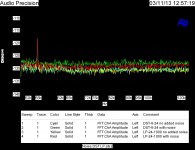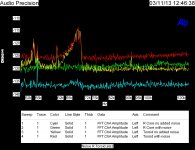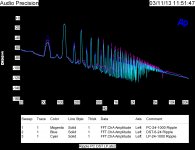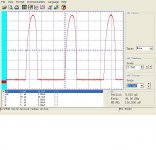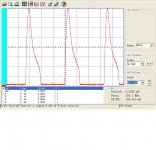Talk to me, jsimon, not anyone else, until the facts are straight.
John the JC-80 is a perfectly nice circuit. Put together with components that are actually available could make a lot of folks very happy.
Thanks, the JC-80's linestage is still working great, the problem seems to lie with the first FETs in the phono section. I have located the Toshiba's for the phono section, but would like to see the schematic so I can check the values.
John
John
This should be an easier fix, but I can't find the input schematic in my files at this time, so I have to ask another question: The phono stage is in 2 parts. Is it the INPUT part that is the problem, or is it the second stage? If it is the input part, then the input devices are the 2SK146 and the second stage is a J73. Note the output of the servos, and make sure that they are not clipping. Good luck, and get back to me.
Actually I can control component temperature these days much better with SMD components and PCB layout, I do quite a few PCB designs that end up in rather exotic units and heat control is quite often a big part of the design. Look at some of the thermal management solutions offered by Avvid and Berquest etc. I have had custom heat extraction aluminium interpostars for between boards or to fix to the bottom of the board with embedded heat pipes, add on board temp sensing and some active heat control and you can run the gear at whatever temp you want. Of course there is some cost in this🙂People compare apples to oranges and call one 'behind the times' Discrete, leaded, analog circuitry needs a certain amount SPACE just to remove the heat from the individual components. If you don't have enough SPACE you often have heat dissipation problems, circuit compromises, by reducing current, or thermal feedback, where you don't want it.
well we're in luck, this is the place where cost is secondary to best performance 😉Of course there is some cost in this🙂
as long as it isnt SMD...
... to compare with Halo JC-2 quite easily and I know it is possible to make a competitive design (at least), even with ICs, when very high quality opamps and buffers are used.
Are you willing to share a schematic to discuss, or is this just hot air ?
No, there is no need to show schematics. I only wanted to say that there are more ways or design approaches to achieve very good/excellent sound and that it should be respected. My post has not been commercially tuned at all.
Of course there are more ways, but you claimed "competitive _at least_".
It was the "at least" which made me curious ...
It was the "at least" which made me curious ...
IF you are happy with an IC based design, PMA, good for you! You have done what I have not yet done. Of course, I can make an IC based design. The JC-3 is an IC based design.
Perhaps the far future is in IC's almost exclusively. However, the NEAR FUTURE, and most of the rest of MY life is going to be with jfets. Almost all the companies that I consult for, and my direct competitors in the audio field, (you know, the guys who usually share the A ratings with me), have reasonable to vast stockpiles of jfets yet to use up.
It would be just like having a large vacuum tube stockpile and being an expert in tube design, being told that you are 'obsolete' and you that should switch to discrete transistors, let's say, 40 years ago. There is 'Marketing Hype' for you. You know: Solid state is better than tubes, IC's are better than discretes, and finally 'Perfect sound forever' with digital. '-)
More than 45 years ago, Dyna shifted from the Stereo 70 (tube) to the Stereo 120 (solid state), the PAS 3 (tube) to the PAT 4 (solid state), later, McIntosh stopped making the C22 (tube) and the 350 (tube), some of the best equipment in the world at that time, and replaced it with solid state 'schlock'. Those designs were EMBARRASSING, because the designers were forced to move prematurely to solid state, when: Really good parts were not available, the resident designers had little experience with solid state, and pre-made designs that were useful for the military-industrial complex, were NOT really that successful processing audio. It took us years of quiet development, behind the scenes, to make the complementary differential input stage, (45 years ago), complementary differential jfet input stage (40 years ago), mosfets weren't even designed yet, and this took another decade, and finally the Japanese took to making exquisite to exotic complementary components for audio, just as a point of pride, to show off their design and fabrication skills, starting about 35 years ago.
We have had a good run, especially with the Japanese parts, but of course, they are being discontinued. Good luck everybody with what is available to you in the future! '-)
Perhaps the far future is in IC's almost exclusively. However, the NEAR FUTURE, and most of the rest of MY life is going to be with jfets. Almost all the companies that I consult for, and my direct competitors in the audio field, (you know, the guys who usually share the A ratings with me), have reasonable to vast stockpiles of jfets yet to use up.
It would be just like having a large vacuum tube stockpile and being an expert in tube design, being told that you are 'obsolete' and you that should switch to discrete transistors, let's say, 40 years ago. There is 'Marketing Hype' for you. You know: Solid state is better than tubes, IC's are better than discretes, and finally 'Perfect sound forever' with digital. '-)
More than 45 years ago, Dyna shifted from the Stereo 70 (tube) to the Stereo 120 (solid state), the PAS 3 (tube) to the PAT 4 (solid state), later, McIntosh stopped making the C22 (tube) and the 350 (tube), some of the best equipment in the world at that time, and replaced it with solid state 'schlock'. Those designs were EMBARRASSING, because the designers were forced to move prematurely to solid state, when: Really good parts were not available, the resident designers had little experience with solid state, and pre-made designs that were useful for the military-industrial complex, were NOT really that successful processing audio. It took us years of quiet development, behind the scenes, to make the complementary differential input stage, (45 years ago), complementary differential jfet input stage (40 years ago), mosfets weren't even designed yet, and this took another decade, and finally the Japanese took to making exquisite to exotic complementary components for audio, just as a point of pride, to show off their design and fabrication skills, starting about 35 years ago.
We have had a good run, especially with the Japanese parts, but of course, they are being discontinued. Good luck everybody with what is available to you in the future! '-)
Last edited:
Just want to note that Toshiba still makes low noise FETs (only n-channel and smd though): 2SK880, 2SK208, 2SK209. And they are cheap...
IF you are happy with an IC based design, PMA, good for you! You have done what I have not yet done. Of course, I can make an IC based design. The JC-3 is an IC based design.
Perhaps the far future is in IC's almost exclusively. However, the NEAR FUTURE, and most of the rest of MY life is going to be with jfets. Almost all the companies that I consult for, and my direct competitors in the audio field, (you know, the guys who usually share the A ratings with me), have reasonable to vast stockpiles of jfets yet to use up.
It would be just like having a large vacuum tube stockpile and being an expert in tube design, being told that you are 'obsolete' and you that should switch to discrete transistors, let's say, 40 years ago. There is 'Marketing Hype' for you. You know: Solid state is better than tubes, IC's are better than discretes, and finally 'Perfect sound forever' with digital. '-)
More than 45 years ago, Dyna shifted from the Stereo 70 (tube) to the Stereo 120 (solid state), the PAS 3 (tube) to the PAT 4 (solid state), later, McIntosh stopped making the C22 (tube) and the 350 (tube), some of the best equipment in the world at that time, and replaced it with solid state 'schlock'. Those designs were EMBARRASSING, because the designers were forced to move prematurely to solid state, when: Really good parts were not available, the resident designers had little experience with solid state, and pre-made designs that were useful for the military-industrial complex, were NOT really that successful processing audio. It took us years of quiet development, behind the scenes, to make the complementary differential input stage, (45 years ago), complementary differential jfet input stage (40 years ago), mosfets weren't even designed yet, and this took another decade, and finally the Japanese took to making exquisite to exotic complementary components for audio, just as a point of pride, to show off their design and fabrication skills, starting about 35 years ago.
We have had a good run, especially with the Japanese parts, but of course, they are being discontinued. Good luck everybody with what is available to you in the future! '-)
Yep, especially with RoHS directive (unleaded) and whiskers growing up as the size of SMDs is ...downsizig, metal can transistors (dissipation) , RN65 resistors , disapear ... i stock for my future 😉
Well since things are quiet, I'll post a few more interesting power supply measurements.
This is the AC line noise that passes through a power transformer. I find the self limiting resonance most interesting.
ES
This is the AC line noise that passes through a power transformer. I find the self limiting resonance most interesting.
ES
Attachments
Cheap shots (not you, Ed).
Thanks, I am two years in on this power supply thing and think I can finish the article.
I found it interesting how much distortion just comes from the transformer even before you add rectifier noise.
Attached transformer distortion with an AC load resistor or not and then with a rectified load. BTY the first graph has a 26 db attenuator in circuit.
So far I have shown transformer distortion, rectification distortion and line noise pass through.
Next I might even show the effects of filtering with big C versus distributed RC.
Attachments
Last edited:
Next I might even show the effects of filtering with big C versus distributed RC.
Make sure you have the Cathode Ray (Scroggie) article on this. He may have scooped you by 50 years or so...
Make sure you have the Cathode Ray (Scroggie) article on this. He may have scooped you by 50 years or so...
I am writing a tutorial. Just showing pictures of current products and how they actually behave. I don't think PC mount flatpack transformers were around 50 years ago. (Close though.)
But if you have a cite...
The new stuff is on how to get rid of DC type effects on transformer primaries.
But if you have a cite...
He also does a mathematical treatment of the general case, so you can plug in whatever frequency you like. I am involuntarily separated from my library at the moment, but if you have a copy of Valve Amplifiers, it's cited in there, and there's scans floating around the intertubes.
He also does a mathematical treatment of the general case, so you can plug in whatever frequency you like. I am involuntarily separated from my library at the moment, but if you have a copy of Valve Amplifiers, it's cited in there, and there's scans floating around the intertubes.
Math! Nobody does math any more. It would screw up opinions, require you to think and know what a pencil and paper are used for.
The thing that popped out was that the transformer uses up 60 degrees of the cycle actually charging, pretty much no matter what the load.
Attachments
- Status
- Not open for further replies.
- Home
- Member Areas
- The Lounge
- John Curl's Blowtorch preamplifier part II
